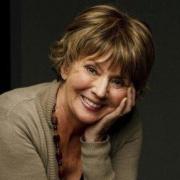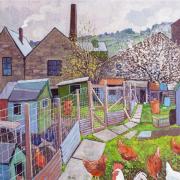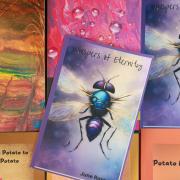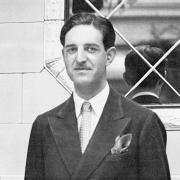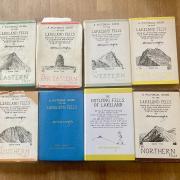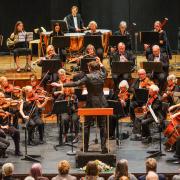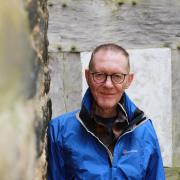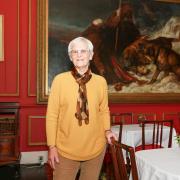Lancashire rock star Jeffrey Hammond is back home and about to reveal his hidden talent for art. But first, he spoke exclusively to Barbara Waite

For a man who has played the world’s biggest venues as bass guitarist with 1970s prog rock giants Jethro Tull, Jeffrey Hammond is a surprisingly private man. In his second career as an artist he has studiously avoided the limelight and only close friends and relatives have ever seen his paintings – until now.
Lancashire Life was given an exclusive interview and the chance to see his works ahead of his first ever exhibition, to be held on the Fylde this month. It fulfils a promise to his late partner Tess who wanted him to share his distinctive paintings with a wider audience.
It is another important milestone in Jeffrey’s life. Born is Blackpool, he has come back to Lancashire where he grew up in a boarding house run by his parents in the shadow of the famous Tower.
He lived the rock star life from 1971-1975 and it all started with a chance encounter at Blackpool Grammar School. A fellow student, Ian Anderson, who had never spoken to him before said: ‘You look like a musician? What do you play?’ It was the start of a friendship that survives to this day.

Ian and another student John Evans wanted to form a group and invited Jeffrey to go with them to see Johnny Breeze and the Atlantics at their local youth club. Watching as the bass player was being mobbed by girls, Jeffrey agreed to be the be group’s bass guitarist despite having no musical training. So it was music, not art, that became the consuming passion during his last years at school.
The group – then known as The Blades – practised in the front room of at John’s mother’s home. ‘We made a horrible racket but in time we progressed from the youth club to doing gigs at workingmen’s clubs in Fleetwood and throughout the Fylde eventually going further afield to Nottingham, Newcastle and Manchester,’ said Jeffrey.
With the repetition of the repertoire the early excitement waned for Jeffrey and he re-took Art A level and joined an art foundation course at Blackpool Tech while his friends kept playing and moved to London.
His tutor suggested he do a painting course, so to apply for college he had to produce a work as part of his portfolio. His picture of a midwife holding a newly-born baby was, in his words, ‘not good’ and, even after it was improved a bit by his tutor, it was still rejected. That meant he could stay in Blackpool. ‘I was thrilled to bits that I would be able stay.’

From an early age, Jeffrey knew he wanted to express himself but had no real idea how to go about it. Luck was on his side and he took up a place at Central St Martins College in London when one of the students dropped out.
Still feeling unsure about the move, he was persuaded by his tutor to go but ‘felt like a fish out of water’ for almost all of the three-year course. ‘The other 19 student already felt themselves to be artists, but I had no sense of direction and learned mostly from a fellow student who is still a good friend to this day.
‘It was not an auspicious start to a career, but during the last six months I felt I was getting somewhere – had found the “something” I was looking for. But what to do next?’
Fate intervened again. After failing an interview to get on a Royal Academy course and with Ian and John’s band – now called Jethro Tull - started taking off, they asked him to house-sit and do some decorating – painting of a different kind – while they toured in America.
On their return he was told: ‘You’re joining the band.’ So within a couple of months he found himself working on the hit album Aqualung and touring Scandinavia. ‘I thought I might last a month, but they were all good musicians and helped me through.’
Adopting the name Hammond-Hammond as a joke – adding in his mother’s surname before she married – he started wearing a black and white striped suit and played a matching guitar – his trademark look and a feature of staged performances of the album, Thick as a Brick.
‘It was fabulously exciting touring the world and I enjoyed it for five years, but inside I knew I wanted to paint – to learn to paint.And that’s what I have been doing all these years. Learning.
‘That stage of my life ended abruptly. I just blurted it out at a business meeting that I was leaving with no previous intention of saying it. It wasn’t the best way to handle it, but the band accepted my decision and moved on.’
By this time Jeffrey had married Mahmaz, an Iranian princess distantly related to the Shah of Persia, and the best friend of Ian Anderson’s wife. Together they set up home in Gloucestershire in a beautiful house with land which Jeffrey developed over the happy years they spent there.
He started painting, though his first attempt at a watercolour of the local view was abandoned. Initially, 90 per cent of his time was spent on the 11 acres of gardens but gradually art took the lion’s share of his time.
The couple travelled extensively, to Iran, Europe and America all documented in Jeffrey’s detailed paintings to give a narrative to their trips.
‘It took me a long while to get used to the slower pace of life after the hectic days of the band. Getting close to nature helped, but I wanted to centre myself and I knew I had to begin the long struggle to learn to paint something meaningful.
‘I started with still life where you have absolute control over everything. I was in the very fortunate position of not having to sell my works so I could develop my ideas exactly how I wanted to. I was very privileged.
‘I had to work hard to achieve the painting style I now have. I didn’t have natural talent and I wanted – still want – each painting to be a challenge, to seize a special moment, to tell a story.
Mahmaz, who came to this country to study at boarding school, was interested in the arts, but more theatre and literature and from their base they were ideally place to visit the RSC in Stratford, theatre in Malvern and Bristol, and Welsh National Opera in Cardiff.
Her untimely death and their son’s decision to move to London forced Jeffrey into another big decision. The house they’d both loved was too big for one – it was time to uproot and start again. ‘It was a huge wrench to leave, but I knew I had to do it.’
He had missed living by the seaside, so travelled from Bognor Regis around the coast right up to Anglesey to try and find a home that felt right, but without success. That is until he returned to the Fylde coast he had loved as a boy, setting up home near to his mother.
Painting in his studio, Jeffrey uses photographs of subjects he has taken which suggest a storyline to him. ‘The photographs are essentially an aide-memoire being unable to paint on the spot for the months it takes me to complete each painting.
‘At a certain point the real painting takes over and I no longer look at the photographs, as the picture is well on the way to becoming an autonomous entity and happily has a life of its own.
‘Each picture I paint demands a fresh approach. It is a matter of instinct and feeling to try to achieve what I want, technical aspects being subservient to that. I don’t take myself too seriously, but I do take painting seriously and hope some of the intended humour is seen.’ A good example of that is the fact he often paints himself in the crowd. Look closely and you might spot him.
‘To use a musical analogy I have been trying to write symphonies or operas rather than three-minute songs; a desire to have the space and time to give to a full narrative,’ he added.
While the painting has been an ever-present in his life there have been reminders of the rock stars days. Seven years ago group leader Ian Anderson travelled to Blackpool to unveil a plaque presented by the Performing Rights Society for Music, commemorating the debut gig of his first band The Blades.
Jeffrey, joined by early fans, attended the ceremony as the plaque was unveiled at Holy Family Church Hall, Links Road, North Shore – life coming full circle.
It was a poignant evening for Jeffrey who had found happiness with a new partner Tess, and his assured paintings show an impressive mastery that he would have hardly imagined during those early music days.
She pressed Jeffrey to organise a public showing of his work as she felt people should see his paintings, but unfortunately she died before the exhibition was organised.
It is her legacy that a small selection of his work is now going on show at the Fylde Gallery in Lytham Booths from November 3 for four weeks. He’s called it ‘All the world’s a stage’ a quote from Shakespeare’s As You Like It. He is certainly a man who has played many parts in his time.
Tull factfile
Ian Anderson, flautist and songwriter, lives in the south of England and is still recording and touring under his own name.
John Evan (correct), keyboards, had his own construction company after he left the band and now lives in Australia.
Barrie Barlow, drummer, worked with Robert Plant and Jimmy page after the band broke up and is still involved in music.
Jeffrey played on Aqualung (1971),Thick as a Brick and Living in the Past (1972), A Passion Play (1973), War Child (1974), Minstrel in the Gallery (1975)




